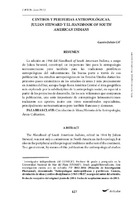Centros y periferias antropológicas. Julian Steward y el Handbook of South American Indians
Abstract
La edición en 1946 del Handbook of South American Indians, a cargo de Julian Steward, constituyó un importante hito para la antropología norteamericana pero también para las tradiciones periféricas antropológicas del subcontinente. En buena parte a través de esa publicación, los estudios antropológicos en los Estados Unidos darían los primeros pasos sistemáticos en los estudios de áreas y más precisamente en América del Sur, aunque luego fuera América Central el área geográfica más explorada por la subdisciplina de la antropología social, en especial a partir de los proyectos de desarrollo. En los seis volúmenes que componen la publicación, una serie importante de antropólogos latinoamericanos realizaron sus aportes, junto con otros renombrados especialistas, principalmente norteamericanos pero también franceses y alemanes. The Handbook of South American Indians, edited in 1946 by Julian Steward, was not only a cornerstone in North American Anthropology, but also in the peripheral anthropological traditions in the rest of the continent. To a great extent, by means of this publication the anthropological studies in the USA were going to make their first systematic steps in the analysis of different areas, more precisely in South America, although eventually Central America was going to be the main objective of the explorations performed by the sub-discipline of Social Anthropology, particularly on the basis of development projects. In the six volumes of the Handbook of South American Indians, there were contributions made by an important group of Latin American anthropologists, together with other prestigious scholars, mainly from the USA, but also from France and Germany.
Collections
- Revista Avá [337]
The following license files are associated with this item:




